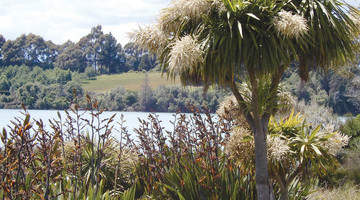Wetland restoration is more than simply planting the wet margins between the land and water. Rob McGowan and Cheri van Schravendijk-Goodman discuss the importance of pausing to listen to what natural spaces can tell us.
Questions for discussion:
- How can you listen to a river or wetland?
- What may these types of observations tell us?
- Why is it important to pause before making observations?
Transcript
Robert McGowan
The whole kaupapa that relates to wetlands is very, very fundamental because water is the gift of life. That’s why they say, “Waiora, homai te waiora ki ahau”, you know. The saying that you hear so often on a marae, “Give me the water that I can be well.”
How do we heal a wetland? Well, you ask it. We’ve got to remember that we can communicate in more ways than just by words. Back in Whanganui running workshops for the river people, I say to them, “You’ve got to ask the river what she wants you to do.” And they say, “Well how do you talk to a river? The river doesn’t speak Māori and doesn’t speak English. It speaks river.” What we have to do is restore our ability to hear what the land is saying.
Wetlands are like any natural place. The first thing is you’ve got to clear yourself so you can connect. There’s lots of talk about karakia these days. Karakia isn’t saying a ritual formula learnt off by heart and you try and get the words correct. The purpose of karakia is to do two things. One, to clear the way. So if you go to a place and your head’s full of business – say, you’ve just come from a meeting or you’ve just got to do the groceries on the way home – all those things stop you from seeing and hearing. And so karakia is essentially, number one, focus your senses on the place and especially on what you’ve come there for. Then you greet it, you mihi to it, then you focus on your kaupapa.
Cheri van Schravendijk-Goodman
I want to give a bigger message to our tamariki and to our people working in their spaces to recognise that they have something powerful and amazing in their minds that the world is looking forward to receiving. As a child, you have big dreams and you have visions, and they are worth taking forward into your adulthood. I’d like you to understand and to believe in yourselves and the value that your knowledge has. Our whakapapa is counting on you to be brave and to step forward and to speak for them. But I’d also like to remind us all to take a deep breath every now and again and to go back to the repo, go back to our rivers and our lakes and to our whenua and ask them sometimes what they need as well.
Acknowledgements
Footage, Rob McGowan in ngahere, brewing a rongoā tea, cleansing in wai and shots of waterfall, from Waka Huia, Scottie Productions
Photo, rama kōura, children silhouetted on lake’s edge, Dr Ian Kusabs
Photo of repo ropu, Yvonne Taura. Sourced from Te Reo o Te Repo – the Voice of the Wetland
Footage of Pūniu River Care Incorporated kaimahi riparian planting, Waikato River Authority


